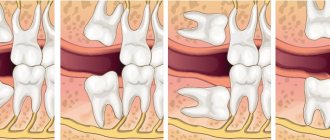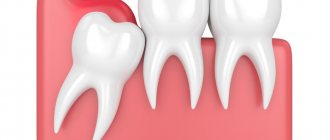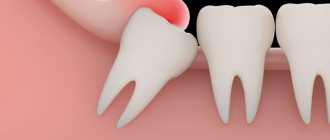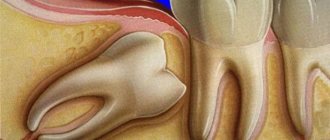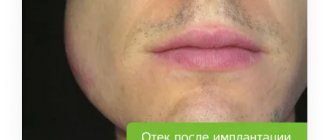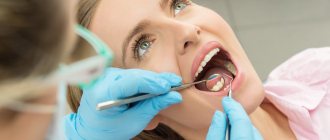Almost every person experiences discomfort during the eruption of wisdom teeth. The intensity of pain symptoms may vary in each individual case, but usually the eruption of third molars is problematic.
When a wisdom tooth grows and the gums hurt, other signs are often observed - swelling of the soft tissues of the mouth, increased temperature, impaired bowel movements, etc. People often try to cope with pathology at home: using traditional methods or anesthetic drugs. However, it must be remembered that all these measures provide only temporary relief of symptoms. Independent actions lead to a worsening of the pathology. Therefore, it is important to know under what signs you can use alternative medicine, and under what signs you should urgently consult a doctor.
Features of wisdom tooth eruption
Wisdom teeth or third molars, also known as figure eights, are the outermost teeth in a row, located at the edges of each jaw. There are four of them in total, but often not all of them erupt, and sometimes they may not grow at all.
This will not affect the chewing functions of the jaw, and if you do not have a single eight, there is no need to sound the alarm.
The eruption of third molars is possible at any age, even after 30 years; the patient’s age does not affect the course of the process. But the direction of growth, the presence of free space in a row, the structural features of the jaw can significantly influence the process - will it be painful or will it go unnoticed, will there be a health hazard and will the growth provoke the development of inflammation.
Reasons for taking so long for teeth to erupt
- The wisdom tooth is very large and there is no room for it.
- Dense bone tissue makes tooth eruption difficult.
- Due to crowding, the tooth does not occupy a natural position: it grows at an angle or parallel to the gum.
Pericoronitis
If the wisdom tooth is slowly erupting, a gum hood may appear over it. This hood prevents the tooth from growing and is a favorable place for food debris and saliva to accumulate. Pathogenic microbes can begin to multiply on this fertile soil.
At the initial stage of development of pericoronitis, it can be stopped with antibacterial drugs. If the disease has developed into a purulent stage, and the patient shows all the signs of infection of the whole body, then the doctor performs a small operation - he cuts the gum and cleans out the pus, thereby helping the tooth to erupt.
Caries
If carious cavities appear on the figure eight, the gums may become inflamed and the tooth will begin to ache. In addition to caries, wisdom teeth are characterized by diseases such as pulpitis and periodontitis. These diseases can be detected by visual examination of the tooth or by x-ray. Treatment depends on the number of cavities and the condition of the paired molar on the opposite jaw.
Other causes of gum inflammation figure eight
- The gums can become inflamed from mechanical trauma or after a burn to the gum tissue.
- With hormonal changes in the body in pregnant women or during menopause.
- For thyroid disease.
- from removable dentures.
- For diseases of the throat and genitourinary system.
- When using hormonal drugs.
Pathologies that require dental care
Eights can take several days, months, or even years to erupt. Growth is accompanied by a slight aching pain, swelling, and redness of the gums - this is the norm.
But there are a number of symptoms that indicate the development of complications and when you should consult a dentist:
- severe acute pain in the gum area;
- pain that spreads to the ear, throat, temples, head;
- increased body temperature;
- inflammation of gum tissue, purulent discharge;
- the appearance of bad breath;
- discomfort, pain when chewing;
- pain when opening the mouth;
- enlarged lymph nodes.
These are signs of inflammation that can lead to infection, loss of adjacent teeth, and sepsis.
Possible pathologies during the eruption of wisdom teeth:
- Incorrect position of the tooth, as a result, it grows sideways into the cheek, injuring, causing pain and inflammation of the soft tissues. At the same time, it causes displacement of the remaining dental units and malocclusion. In the worst case, a malignant tumor may form. It is impossible to correct the direction of growth; the incorrectly growing molar must be removed.
- If it grows towards an adjacent unit, it will damage or completely destroy its crown. The pathology is accompanied by constant severe pain, the inability to chew food normally, and talk. The solution to the problem is surgical removal.
- Pericoronitis is inflammation of the gums. Since the third molars are located in an area that is difficult to clean, leftover food, drinks, and microbes get into the gum tissue. Bacteria cause infection, inflammation, dangerous intoxication of the body, blood poisoning. Symptoms of pericoronitis include severe swelling of the gums, facial asymmetry, acute persistent pain, purulent discharge, and high fever. You should contact the clinic immediately.
First aid
Before going to the dentist, you can relieve pain at home using certain pharmaceutical products.
- Drink a painkiller drug - Nimid, Nice, Analgin, Ketanov, Paracetamol, Tempalgin.
- Place the turunda on the swollen area with a special ointment or gel - Kamistad, Dentinox, Metrogyl-Denta, Cholisal.
- Rinse the mouth with antiseptic solutions - Miramistin, Chlorhexidine and Furacilin.
You can use home help methods for three days. Next, the supervision of a professional doctor is necessary. If the pain does not go away and the swelling does not go away, then you should immediately visit a dentist to find out and eliminate the cause of the painful condition. Inflammation during pericoronaritis is relieved by washing the gingival hood with pharmaceutical antiseptic solutions: Iodopharm, Potassium permanganate, Furacilin.
How to eliminate pain and discomfort
In the absence of pathologies, it is possible to eliminate pain by taking painkillers Nurofen and Ibuprofen. Ideally, consult your dentist before using anesthetics.
It is impossible to accelerate growth or influence the process, but you can facilitate it by cutting the gum. The decision about surgery is made by the dentist based on the clinical picture.
Minor inflammations can be easily removed by rinsing the mouth with antiseptic compounds and herbal decoctions. Otherwise, all you have to do is wait for the tooth to erupt. A consultation with a specialist will allow you to identify deviations in time and prevent risks.
What to do if swelling does not go away?
If, after wisdom tooth removal, pain and swelling of the cheeks do not go away within a maximum of five days or, on the contrary, increase, then you should urgently visit a doctor. It is highly desirable that this be the same specialist who performed the removal. It is necessary to inspect the hole and take appropriate measures.
You should also see a doctor in the following conditions:
- the temperature does not decrease on the second day;
- general weakness and poor health - perhaps this is a consequence of intoxication;
- hardened areas near the removal site;
- increasing pain when swallowing or opening the mouth;
- there is no blood clot in the socket.
Causes of the inflammatory process
It is not unusual for a dentist when patients come to him and complain that the gums near the wisdom tooth are swollen. No one is safe from such an incident.
Eights are specially designed, for example, they never have milk teeth predecessors, which causes them to take a long time to form, they have a different root system from the rest and begin to erupt quite late.
All people have the rudiments of molars on the distal part of the jaw, however, not all people develop completely and turn into a full-fledged tooth. In some of the population, they never begin to emerge or do not emerge completely.
Note. Wisdom teeth always grow for a long time and very slowly. This often causes discomfort, and in some cases, serious inflammatory processes, so it is important not to delay your visit to the dentist. The patient will be examined and given instructions on further actions.
Temperature after wisdom tooth removal –
- If the tooth was removed not due to inflammation - If you have a wisdom tooth removed - the temperature can normally rise to 37.5 degrees, but only on the first evening.
The body sometimes reacts to injury with just such a low-grade fever, even if the tooth was not removed due to inflammation. This is especially true if the removal was difficult. Normally, the temperature should disappear the next morning after removal. When you need to sound the alarm - but if the temperature does not subside the entire next day after removal, and even more so continues to increase, then this clearly indicates the addition of an infection. You need to run to the dentist. - If the tooth was removed due to purulent inflammation, in this case the numbers on the first evening may be slightly larger than 37.5. Normally, from the next day the temperature should decrease progressively. If it persists and even increases, then you need to urgently go to the dentist.
Symptoms
The disease can develop from an acute to a chronic stage and have both purulent and catarrhal forms.
The initial stage is acute catarrhal pericoronitis. It has the following symptoms:
- Local aching pain at the cutting site.
- Swelling of the “hood”.
- Sharp shooting pain radiating to the ear and temple.
- Slight increase in body temperature.
- Headache.
Inflamed hood over a wisdom tooth
If no treatment is given at this stage, the disease may progress to the second stage - chronic purulent pericoronitis. In this case, the following signs are observed:
- Improvement in general well-being relative to the first stage.
- Pain when swallowing and chewing.
- The presence of pus at the site where the tooth appears.
- Bad breath.
- Damage to the lymph nodes in the lower jaw.
This stage is the most dangerous and indicates that the inflammation has turned into an abscess and has penetrated deeply into the soft tissue.
The larger the abscess grows, the more difficult it will be to get rid of it completely, which can lead to a cystic cavity.
As a result of these processes, inflammation can also spread to the cheek, causing swelling. At the same time, swelling of the cheek (parotitis) can occur even in the absence of pain in the place where the “third painter” grows. If the wisdom tooth has already erupted and is growing in the wrong direction, then the cheek may also become swollen if it is constantly bitten while eating.
What can you do to relieve swelling?
Removing wisdom teeth is usually more difficult than removing incisors, canines, and other molars. The intervention causes significant trauma to the tissues surrounding the rudiment, neighboring units, and jaws. The patient must strictly follow the advice given by the dentist.
- Elimination of physical and emotional stress after a radical event. It is useful to refuse to eat for 3 hours. Until the wound heals, you should include soft, tender food in your diet, and do not touch the hole with your hands or tongue. Following these rules will help relieve cheek swelling faster.
- Swelling will be reduced by a compress of ice cubes. It is applied on the first day. The cold will also relieve pain.
- A compress of salt and soda in a ratio of 0.5: 1 is widely used. The mixture is applied for 7-15 minutes several times a day.
- Special ointments and gels will relieve swelling. It must be prescribed by a dentist.
- Worry should be avoided and stress should be avoided so as not to worsen your overall health.
- It is useful to sleep on a pillow that is raised high.
Causes of swelling of the cheek and gums during wisdom tooth growth
A “hood” appears over the erupting “third molar,” just like over any other tooth that begins to grow. It is a fold of gum, which, if the tooth is positioned correctly, should be cut by it, giving way for further growth. But, if there is a shortage of space, the “hood” remains. Residues of food can get there and, in combination with insufficient cleansing of the space closed by the gums with saliva, the growth of harmful bacteria occurs. As a result, an inflammatory process begins - pericoronitis.
This disease can be provoked by reasons related to external factors, or as a result of delaying the cutting process itself. The first case includes:
- Injury to soft tissues around a growing tooth by hard food particles or a toothbrush.
- The appearance of small ulcers or erosions on the gums.
Tightening of cutting occurs in the following cases:
- Lack of free space in the oral cavity.
- Increasing the thickness of the gums at the cutting site.
- An increase in bone tissue density associated with the absence of a preliminary presence of a baby tooth in the places where the “eight” appears.
The later a person’s wisdom tooth grows, the more severe and painful the consequences accompany the process of eruption.
Pericoronitis: how to treat gum inflammation at home?
Pericoronitis is accompanied by very unpleasant sensations. This disease occurs just during the eruption of a wisdom tooth, and you need to know how to relieve inflammation of the figure eight, especially in the lower jaw.
Surgical removal of the hood is only half of the treatment; the crown continues to erupt, so you need to prevent inflammation at home. It is important to give the figure eight space to erupt in a timely manner in order to eliminate infection and all its consequences. If your figure eight is erupting and this is accompanied by unpleasant symptoms, it is better not to delay and contact Leaderst dentists. At a free consultation, you will receive information that will protect you from teething problems, help you avoid tooth extraction and maintain oral health.
What to do and how to treat the gums when the figure eight erupts on the upper and lower jaws?
- Clean the oral cavity thoroughly, despite slight discomfort, since the largest number of microorganisms accumulate in the area of the erupting figure eight, which can cause pericoronitis;
- Use additional hygiene products: irrigator, rinses are very important for the prevention of gum disease not only during the teething of the figure eight, but throughout life;
- The eruption itself, even without inflammation, causes discomfort, and to relieve pain in the area of the third molar, you can take drugs such as Nimesil, Ketanov, Nise, Ibuprofen, they not only relieve pain, but also fight inflammation in the tooth area;
- Under no circumstances should you apply hot compresses to your cheek, and especially to your tooth; only cold compresses can relieve pain for a while;
- It is necessary to treat the hood not only locally, but also by following general principles, that is, eat right, avoid hypothermia, since a decrease in the protective mechanism provokes an intensification of the clinical picture, and then it will be more difficult to remove the infection and relieve pain;
- You also need to treat inflammation with folk remedies: rinse your mouth with a decoction of chamomile, sage, oak bark, and take baths.
